skip to main |
skip to sidebar
I've posted a pakoda recipe before, but I thought I'd do a post on this version because, for one, it IS slightly different and for another, I really REALLY like my photo and think it deserves to be enshrined on my blog for posterity to view over and over.
HAHAHAHA!
My mother's version (which is the only one I've used all these years) for vegetable pakoda does not involve ginger-garlic paste. This time I decided to add it, and gosh, what a difference it made to the taste! The mint also added a refreshing note. I recommend it.
Oh, and while you're considering my recommendation, make sure you guys admire my beautiful photo of the pakodas. I recommend that too.
Recipe for: Mixed vegetable pakoda
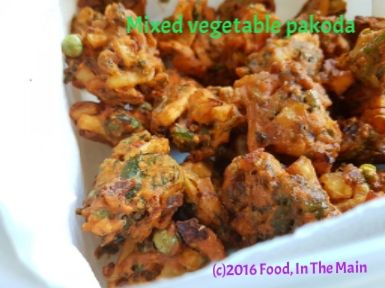
Ingredients:
1 medium potato
10-12 green beans
1/5 small cauliflower
1 medium carrot
1 cup spinach
1/4 cup green peas
1 medium onion
1 tbsp ginger-garlic paste
2 tbsp finely chopped mint
1 tsp omam/ajwain/oregano seeds
1 tsp red chilli powder
1 tsp coriander powder
1.5 - 2 cups chickpea flour
2 tbsp rava/semolina
Salt to taste
Oil for deep frying
Method:
1. Peel the carrot. Chop all the vegetables into thin 1/2-inch long strips.
2. Heat the oil in a deep wok. While the oil is heating, in a large mixing bowl, mix together all the chopped vegetables, spice powders, grated ginger and garlic, the semolina and the chickpea flour. Mix well, then add salt to taste and mix again. Add 1/4 cup water and mix with your hands to a thick dough. It should not be runny at all, because the vegetables will exude water. And once the dough is mixed, use it straightaway.
3. Drop a small piece of dough in the oil - if it floats to the top rightaway, the oil is ready. Drop the mixture carefully into the oil by the tablespoonful. Don't crowd the oil or the pakodas will not be crisp and soak up the oil. Once they are an even golden brown, remove from the oil and drain onto kitchen paper.
4. Serve warm. Great with drinks.
Until yesterday, I'd only ever seen nankhatai in photos on various blogs (most of them very, very beautifully shot photos, I might add). Never seen them in real life, never eaten any (not that I know of and not by that name), never baked any. Since Diwali is next week, and because I'd just bought a lovely big bag of pistachios recently, and also because our friends were going to drop by and I wanted to bake something for them with an Indian touch, I decided to make nankhatai with the pistachios and the last of my stash of saffron. The recipe I followed is on Nandita's Saffron Trail blog. My only two additions were pistachio nuts in the dough itself, and extra milk as the ghee alone was nowhere near enough to bind the mixture together to make a dough.
And what a good decision it was. I love saffron - although I don't use it often because it's expensive - and I love pistachios, and I know they're a flavour match made in heaven (fictitious place, obvs, but the match is very real and the flavours are very lovely!). These cookies are very moreish - they're not too sweet, the saffron flavour is awesome, the pistachios are delicious and the semolina gives the nankhatai a lovely crunch. Be sure to use fine semolina, though, otherwise, the nankhatai might have a sandy mouthfeel rather than crispness. Happy eating, people!
Recipe for: Kesar pista nankhatai (saffron pistachio cookies)
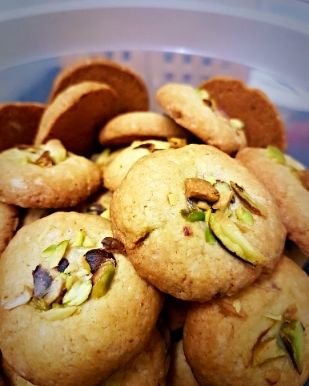
Ingredients:
1.5 cups plain flour
2.5 tbsp chickpea flour
1/2 tbsp fine sooji (semolina)
1/2 tsp baking soda
1/4 cup slivered pistachio nuts
2 tbsp finely chopped pistachios (optional)
1/2 cup powdered sugar
1/2 cup melted ghee (clarified butter)
1/4 tsp saffron strands, crushed in a small mortar-pestle
Milk as required
Method:
1. Preheat the oven to 180C/350F.
2. Sift together the flours, semolina and baking soda in a medium bowl. Mix in the slivered pistachio nuts and set aside. Warm 2 tbsp of the milk and let the saffron steep in it for 5 minutes.
3. In a large bowl, mix together the ghee, powdered sugar and saffron-milk until smooth, then add the flour mixture. Add extra milk a tablespoon at a time until you can form a soft dough. Be careful not to add too much liquid.
4. Roll the dough into balls the size of large marbles and place on a cookie sheet lined with non-stick paper or foil, leaving a gap of about 1.5 inches. At this point, if you wish, you can make a dimple in the centre of each cookie with your thumb and sprinkle a pinch of the chopped pistachios. If not, just flatten each ball slightly and place in the preheated oven.
5. Bake for 15-18 minutes or until the cookies are a pale brown, switching the tray around after 10 minutes so that they brown evenly.
6. Remove to a wire cooling rack. The cookies will crisp up as they cool.
7. Try not to eat all the nankhatai yourself.
I can't seem to get enough of karela or bittergourd nowadays - I really love these ugly knobbly vegetables that look like a bit like rats with a long tail. A couple of days back, I went to my favourite "Indian" shop in Wellington for vegetables, and was beyond thrilled to find small baby karela for sale. I picked out the freshest 10 and came home joyfully, having decided how I was going to cook them. Stuffed, basically. I didn't want the stuffing to be the usual onion masala or potato masala or peanut-based masala - mainly because I didn't want to spend time cooking the stuffing. Bad enough that I would have to wait for the karela itself to cook.
So I just put together a random mixture of flours and spices, toasted the mix in a dry pan until fragrant, then used some oil and water to bind the powdery mix and make it amenable to stuffing, basically.
I admit that this recipe uses more oil than usual, but it's worth it if you love karela and only make it once in a while. It was SO delicious. I had the stuffed karela with lemon masoor dal and rice and a little ghee, and felt like I had gone to heaven without having to die first. Yes, THAT good.
So good that I forgot to take a photo before diving into the karela. Oops...
Recipe for: Stuffed karela
Ingredients:
6-8 small (about 4-5 inches length) tender karela
For the masala paste
1/4 cup soya flour or jowar flour
1/2 cup chickpea flour (besan/kadalai maavu)
1/8 cup rice flour
4 tbsp coriander powder
1 tsp cumin powder
1/2 tsp aniseed powder
1/2 tsp fennel powder
1 tsp garam masala/rasam powder/any other masala you prefer
2 tsp red chilli powder (or to taste)
1/4 tsp asafoetida powder
Salt to taste
4 tbsp oil
Method:
1. Lightly peel the karela so that the ridges no longer stick out. Make a slit in each karela from end to end, being careful not to cut right through to the other side.
2. Use the handle of a small spoon to gouge out the inner seeds and membrane.
3. At this point you can rub salt on the inside and outside of the karela and let it sit for a few hours so that some of the bitter juices are drawn out. If you do this, be sure to squeeze the juices out, then wash the karela well to remove the excess salt. Pat dry with kitchen paper and reserve.
4. Mix together all the ingredients for the masala paste, bar the oil. Heat a pan and dry toast the mixed masala powder, stirring constantly, until the flours start to smell fragrant and savoury. Be careful not to burn it.
5. Once the masala mix is toasted, transfer it to a container. This might be more than you require, but you can always store the excess for another day in an airtight container. I prefer to make extra, because I don't like it when I find out halfway through stuffing that there isn't enough masala paste to fill all the karela. so you can use all of the toasted mix, or just half, depending on how many karela you have and their size.
6. Now add 2 tbsp of the oil to the masala powder and stir it in. The paste needs to come together enough that if you pinch some together, it shouldn't fall apart. You can add a bit more oil to get the powder to that stage, or you can add a little water. Either way, don't make it into a gooey paste.
7. Once the masala mix is ready, use your fingers to stuff it into the karela. Once they are all stuffed, you can use kitchen string to tie the karela so the stuffing doesn't come out (it tends to expand a bit as it cooks), but it's not strictly necessary especially if the karela is small.
8. Heat the remaining 2 tbsp oil in a pan and add 1/4 tsp asafoetida to it. As soon as it sizzles, put the stuffed karela in the pan and stir them gently so they are coated in the oil. Sprinkle 2-3 tbsp water over the karela and close the pan. Cook the karela covered over medium-low heat for 15 minutes or until they soften and turn a paler green. After that take the lid off and turn up the heat a bit more, occasionally turning them over, until they turn brown and crisp on all sides.
Serve hot with dal and rice.
It's been years since I first saw this recipe on Bee & Jai's amazing food blog, Jugalbandi, and every so often since then I've thought to myself "I really should try making those peanuts" but never got around to it.
Finally, last week I broke through the "must make it" barrier to burst triumphantly into the "WILL make it today" arena... only to find that I was out of raw peanuts. Cue frantic trips to Tesco, Sainsbury's and Morrisons on a desperate hunt for peanuts - whole, skinned, broken, unskinned, whatever I could get - but all I found were monkey nuts or the ready-to-eat salted/roasted kind.
You can have no idea just how thwarted I felt, because I'm certain that most of you wonderful people are the kind that don't thwart easily (especially if you live close to any ethnic food-stores). But me, I had to go back home empty-handed and log on to an Internet site that sells all manner of ethnic goodies... and peanuts. Raw, whole, broken, unskinned, pink, red, jumbo - pretty much every kind of peanut I could think of.
Reader, I bought them.
For my first batch of these addictively good masala peanuts, I changed the quantity of the spices used, not the spices themselves, and added fresh curry leaves. But the procedure was otherwise exactly as set out by Bee and Jai. (I made another batch for Pete with no chilli powder at all, and he scarfed the peanuts down like they'd been made for him. Oh. Wait...)
A note of warning - I used an enamelled metal tray to bake these peanuts, and I must say that it took some serious elbow grease to get it cleaned of the rock-hard baked-on chickpea flour mixture. Did I mind the effort? Not in the least - all I had to do was think of the container of uber crunchy spicy peanuts, and the hard work was totally worth it. Just - whatever you do, don't use a non-stick tray. You have been warned.
Recipe for: Baked masala peanuts
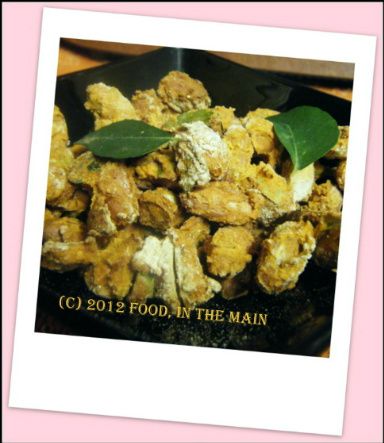
Ingredients:
1.5 cups raw peanuts (skinned or unskinned)
1.5 cups chickpea flour (kadala maavu/besan)
2 htsp red chilli powder (or to taste)
1/2 tsp ground ajwain (bishop’s weed)
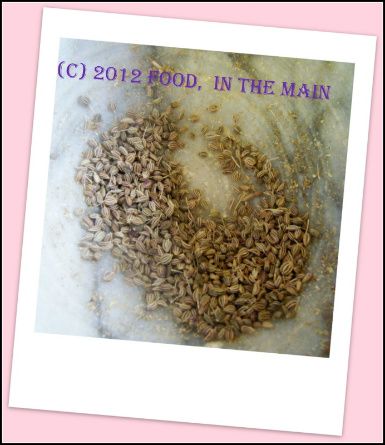 1 tbsp dried fenugreek leaves (kasoori methi)
1.5 tbsp rice flour
Handful of fresh curry leaves, roughly torn up
Salt to taste
Water as required
1 tbsp dried fenugreek leaves (kasoori methi)
1.5 tbsp rice flour
Handful of fresh curry leaves, roughly torn up
Salt to taste
Water as required
Method:
1. Mix together the chickpea flour, red chilli powder, ground ajwain, fenugreek leaves, curry leaves, rice flour and salt to taste.
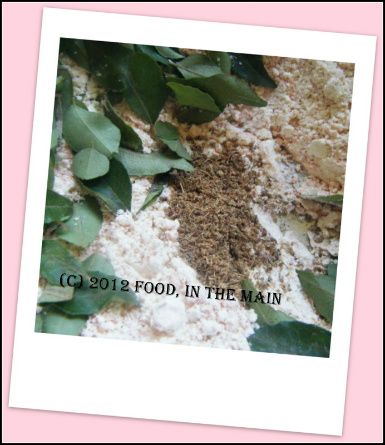 2. Take half the spiced flour in a bowl and carefully add just enough water
2. Take half the spiced flour in a bowl and carefully add just enough water
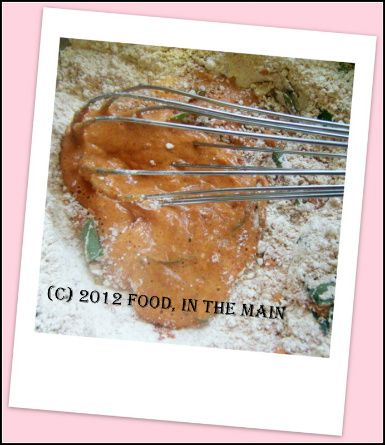 to make a thick paste that drips slowly off a spoon.
to make a thick paste that drips slowly off a spoon.
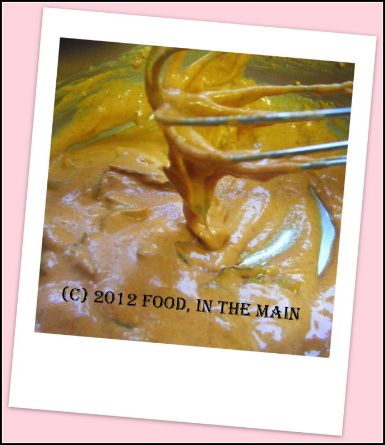 3. Add the peanuts to this and mix well.
3. Add the peanuts to this and mix well.
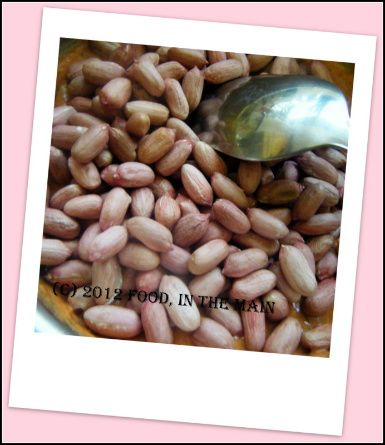 4. Now add the remaining spiced flour and mix it gently. Be warned, this is an exasperatingly sticky job.
4. Now add the remaining spiced flour and mix it gently. Be warned, this is an exasperatingly sticky job.
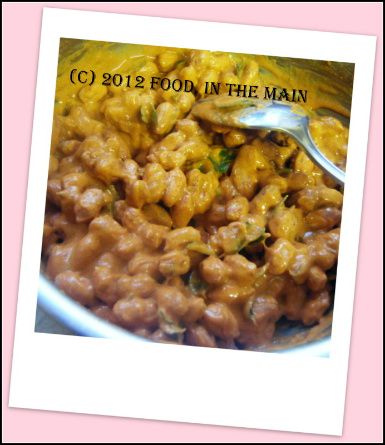 5. Spread the peanuts onto a metal baking tray. (See warning above of exasperating stickiness. Persevere.)
5. Spread the peanuts onto a metal baking tray. (See warning above of exasperating stickiness. Persevere.)
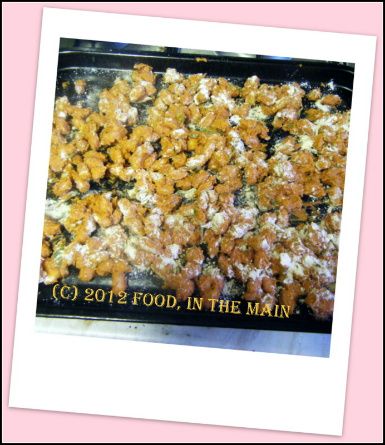 6. Bake at 180C/350F for 15 minutes, then stir the peanuts around, using a metal spatula to scrape and loosen the worst bits.
6. Bake at 180C/350F for 15 minutes, then stir the peanuts around, using a metal spatula to scrape and loosen the worst bits.
 7. Bake for another 8-10 minutes, until the peanuts turn a darker colour in spots. They will crisp up as they cool down.
7. Bake for another 8-10 minutes, until the peanuts turn a darker colour in spots. They will crisp up as they cool down.
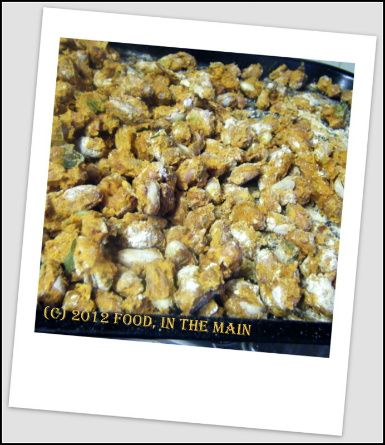 Stir them around once or twice as they cool.
Stir them around once or twice as they cool.
 Store in an airtight container.
Store in an airtight container.
RECIPE: BAKED MASALA PEANUTS
Ingredients:
1.5 cups raw peanuts (skinned or unskinned)
1.5 cups chickpea flour (kadala mavu/besan)
2 htsp red chilli powder (or to taste)
1/2 tsp ground ajwain (bishop’s weed)
1 tbsp dried fenugreek leaves (kasoori methi)
1.5 tbsp rice flour
Handful of fresh curry leaves, roughly torn up
Salt to taste
Water as required
Method:
1. Mix together the chickpea flour, red chilli powder, ground ajwain, fenugreek leaves, curry leaves, rice flour and salt to taste.
2. Take half the spiced flour in a bowl and add enough water to make a thick paste that drips slowly off a spoon.
3. Add the peanuts to this and mix well.
4. Now add the remaining spiced flour and mix it gently. Be warned, this is an exasperatingly sticky job.
5. Spread the peanuts onto a metal baking tray. (See warning above of exasperating stickiness. Persevere.)
6. Bake at 180C/350F for 15 minutes, then stir the peanuts around, using a metal spatula to scrape and loosen the worst bits.
7. Bake for another 8-10 minutes, until the peanuts turn a darker colour in spots. They will crisp up as they cool down. Stir them around once or twice as they cool. Store in an airtight container.
I've always thought that puris referred to only one thing - small, airy, puffed up fry-breads made with plain or wholewheat flour. When I came across a recipe for "besan ki puri" on The Veggie Hut, I fully expected it to be a deep-fried recipe, differing from a regular "atte ki puri" (wheatflour puris) by the addition of besan or chickpea/gram flour. I was quite surprised to find that these besan ki puri were merely shallow-fried, and they looked like regular chapaties or parathas. So perhaps besan ki puri is a regional or colloquial name for this type of stuffed paratha/chapati, although I'm not sure where this recipe originated or which State it's from.
The recipe was interesting, though - I'd never come across a seasoned chickpea flour filling for chapaties, nor even heard of such. The filling was simple enough to make, and certainly I found it a lot easier to handle while rolling out the chapaties. (Wetter fillings have been known to squirt out annoyingly no matter how gently I wielded the belan (rolling pin).)
Until now I've only had the western-type pastry rolling pin, very large and very heavy and the same width from end to end, compared to the Indian ones which are far lighter and tapered towards the ends. I've recently acquired one of the latter kind, so yaaay! I'll have to see if they make a difference while rolling out chapaties. It could well be that my faulty technique, and not the rolling pin, is the factor that brings the filling leaping so joyfully and messily out of the chapati dough...
Anyway, what I discovered while rolling out these chickpea-flour-filled chapaties is that I got a few air pockets at the start... but some light pressure while rolling them out ensured that the air leaked away gently instead of literally tearing its way out of the dough. That's my kitchen tip for the day.
PS. The term "kitchen tip" does NOT imply that my kitchen is a rubbish area. Just so you're aware.
Recipe for: Chapaties with gram flour filling
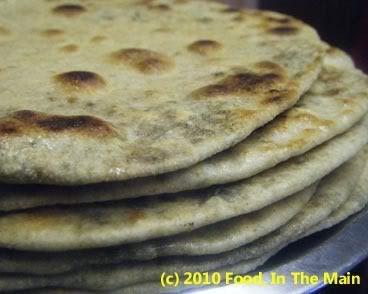
Ingredients:
3 cups wheat flour
Salt to taste
water as required
For the filling:
1 cup chickpea/gram flour
5-6 green chillies, chopped finely
1 tbsp coriander powder
1/2 tsp cumin powder
2 tbsp dried fenugreek leaves (kasoori methi)
1 tsp red chilli powder
3-4 tbsp water 1 tbsp oil
Salt to taste
Pam or other non-stick spray (or oil for cooking)
Method:
1. Put the flour into a deep mixing bowl, add a little salt and knead to a smooth pliable dough using as much water as required. Cover the dough and let it rest for 15-20 minutes. 2. Heat the oil in a frying pan and add the green chillies, coriander powder, cumin powder and kasoori methi.

3. Stir-fry them for 30 seconds on high heat.
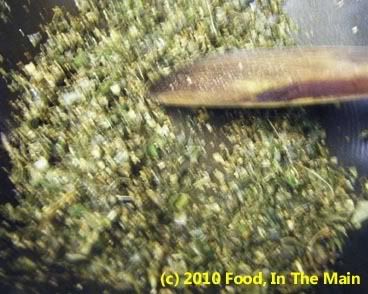 4. Add the besan (gramflour/chickpea flour), stir till the ingredients are well mixed.
4. Add the besan (gramflour/chickpea flour), stir till the ingredients are well mixed. 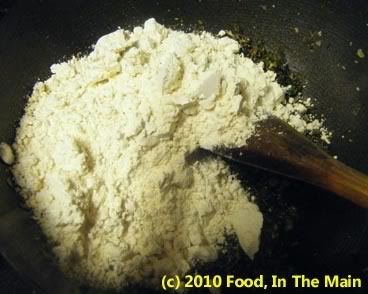
5. Continue stir-frying on medium heat, till the flour turns a darker shade and emits a roasted aroma. Be careful not to burn the flour. 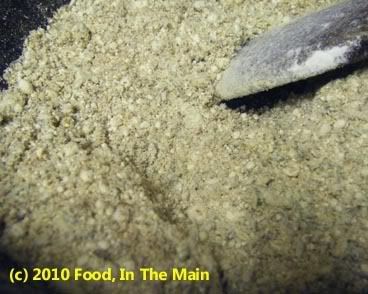
6. Add the turmeric powder, red chilli powder and salt to taste, and mix well. 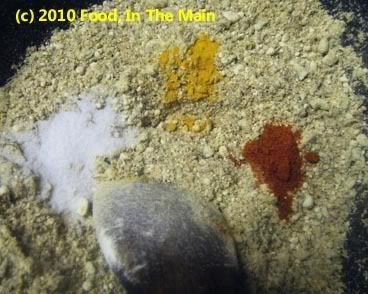
7. Now add water, tbsp by tbsp, stirring between each addition, 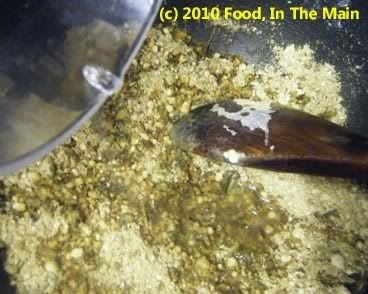 until the roasted flour begins to come together in clumps.
until the roasted flour begins to come together in clumps.  Only add enough water to lightly moisten all the flour, but it's better to stop while the flour is still a bit dry than to add too much and make it sticky wet. If that happens, the best thing to do is start over. Let the filling cool completely once it has become moist.
Only add enough water to lightly moisten all the flour, but it's better to stop while the flour is still a bit dry than to add too much and make it sticky wet. If that happens, the best thing to do is start over. Let the filling cool completely once it has become moist.
8. To make the chapaties, pinch off a ping-pong ball sized piece of dough. Flatten it in a saucer of dry flour, shake off the excess flour, then roll the dough out into a 4" circle. Place 2 tbsp of the filling in the centre. 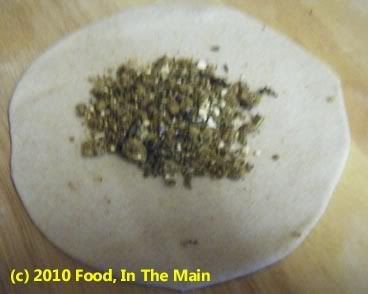
Bring the edges of the chapati together to enclose the filling completely. 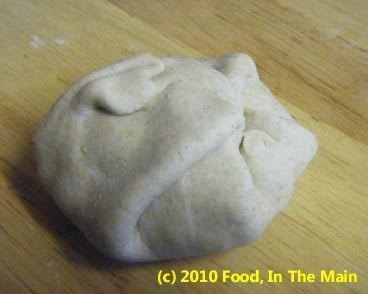
Turn it over so that it lies seam-side down, then start rolling it out again. If any air pockets are visible (the puffed up area), continue rolling but do it more gently, so as to get rid of the air. 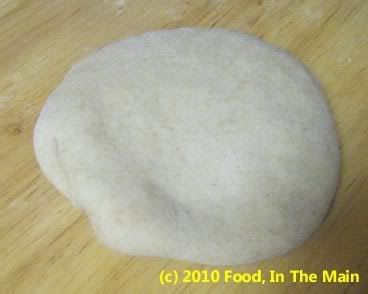
Continue rolling out the chapati till it is evenly thin all over. 
9. Heat a tava or frying pan on medium heat, then place a chapati on the tava for 10-15 seconds, or till small brown spots appear. 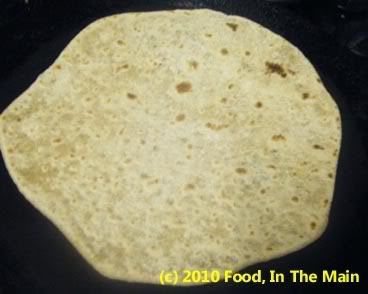
Turn it over and spray the partially cooked side with Pam, then flip it over again to spray that side as well. 10. Cook on medium heat for about 2 minutes for each side, pressing down with a spatula to let the chapati cook evenly all over. Keep the cooked chapaties covered and warm in a clean cloth-lined plate while you make the rest of the chapaties the same way. They can be cooked till very crisp (which will take longer), almost like a cracker, if you like. 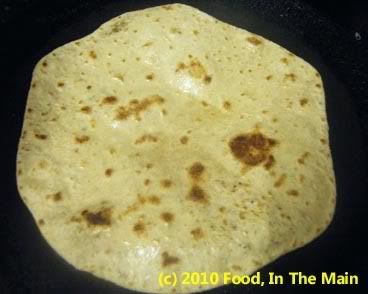
11. Serve hot with a curry, or with pickles and yogurt.
I have a favourite new snack – baked vegetable pakodas (fritters). Granted, they don’t look like traditional pakodas, and possibly they don’t taste traditional either (read “deep-fried”) – but boy, they DO taste really good. Actually you might as well call them savoury cookies because I flattened them for more even baking. Whatever (a rose by any other name and all that...), these are extremely more-ish when fresh, with dips.
These pakodas become kind of chewy and hard the next day, but I liked them that way nevertheless. But then I’m odd like that. So if you're not like me, eat 'em fresh. I dont know if they would soften when re-heated in a microwave, because I didn't try that for myself. (But if you do, let me know what happens, please.)
Recipe for: Baked vegetable pakodas
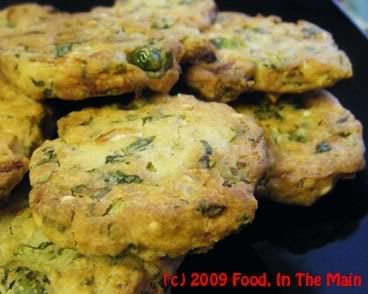
Ingredients:
1 small potato, boiled and grated
1/2 cup fresh peas
1/2 cup green beans, chopped 1/2cm thick
1/2 cup spinach leaves, sliced
1 medium onion, chopped fine
10 cashew nuts, chopped
1/4 cup chopped coriander leaves
1/4 tsp cumin powder
1 tbsp sesame seeds
1 cup gramflour (besan/chickpea flour/kadala maavu)
1 cup rice flour
1/2 tsp chilli powder or 2-3 fresh green chillies, minced (optional)
Salt to taste
1 tbsp oil
Water as required
Method:
1. Preheat the oven to 180C.
2. Microwave the green beans and peas for 4 minutes on full power with 4 tbsp water.
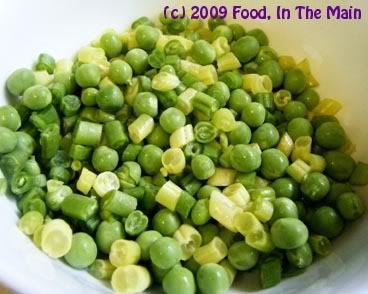
Transfer to a large bowl.
3. Add the grated boiled potato, spinach leaves, chopped onion, cashew nuts, coriander leaves, cumin powder, sesame seeds and mix well.
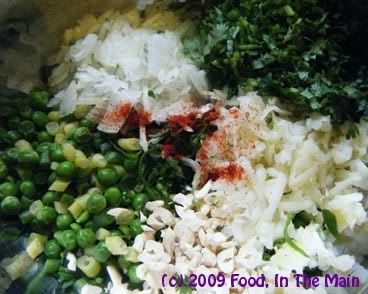
4. Add the rice flour and gram flour along with salt to taste.
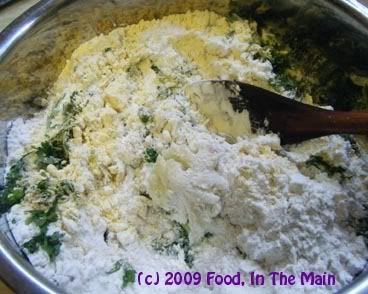
5. Mix with your hand now, adding water little by little until the dough comes together and you can make small balls with it. Do NOT make the dough watery. It should be thick and will be a bit sticky.

6. Heat the oil till it’s smoking, then pour onto the dough.
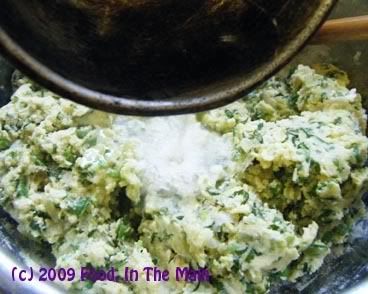
Wait a couple of minutes for it to cool before mixing it into the dough (or use a spatula).
7. Line a couple of baking trays with silicone or non-stick paper and additionally spray it with Pam or similar non-fat spray. Make small balls of the dough, place on the tray and flatten evenly with your fingers. You might need to wipe your fingers clean every so often.

Spray the tops of the pakodas with a spritz of Pam, then bake in a 180C oven for 15 minutes.
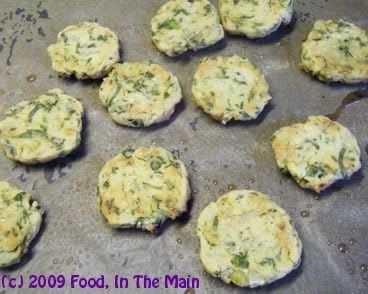
After that turn them over, and bake for another 15 minutes or till the pakodas are lightly browned on top.
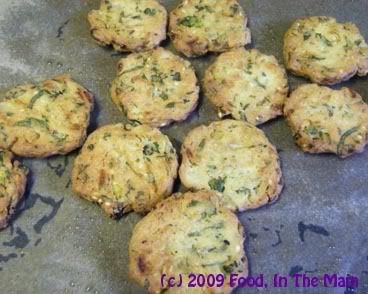
If you like them to be crisp, bake for a few minutes longer (but keep an eye on them).
8.Serve warm, with or without dips, as a snack.
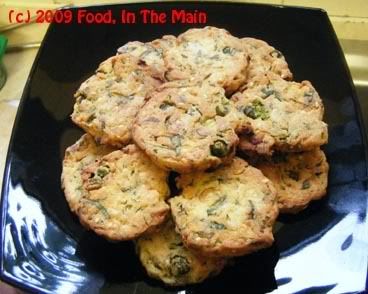
I've got a glut of recipes to post, but I've just been unable to make myself do anything to put them on my blog. Especially the ones that need more elaborate instructions than I feel like dealing with at the moment. Obviously I'm a dedicated foodie but my blogging muscle sometimes wilts a bit and doesnt want to hold itself up.
So here's a simple recipe, just to ease myself back into the food blogging world. Didnt help that Pete and I made a quick 6-day trip to Seattle last week... it only served to increase my laziness in the blogging department because I felt so utterly enervated. It wasnt a bad week but boy, the travelling to and fro really sapped my energy!
Anyway, I didnt feel like cooking either, yesterday, and Pete only wanted eggs and chips.

So I made the chips from scratch, based vaguely on Aunt Bessie's lightly battered oven chips (which we get here and which are tastier than regular oven chips - and less healthy, goes without saying). Mine is a much simpler version. Also, I didnt make a wet batter for the potatoes, just shook them up with some seasoned gram flour and baked them till golden and done. Pete dipped his wedges into sunny-side up eggs and I had mine with a yogurt dip - that is, I mixed idli podi with yogurt and used that as a dip. It was yummy!
Recipe for: "Dry batter" oven baked potato wedges

5-6 medium red-skin potatoes, washed and cut into wedges
2 generous tbsp gram/chickpea flour
1 tsp red chilli or cayenne powder (adjust to taste)
1/2 tsp coriander powder
1/2 tsp jeera/cumin powder
1/2 tsp freshly milled black pepper powder
Salt to taste
2 tsp oil
Method:
1. Mix the chickpea flour and the various seasonings (bar the salt) together.
2. Put the wedges in a large ziploc bag (or a large dry bowl), pour in the 2 tsp oil, close the bag and shake the potatoes well. Then add the seasoned chickpea flour and shake it all aain until the potatoes are coated as evenly as possible.

3. Spray a shallow baking sheet with Pam or line with silicone paper. Spread the seasoned wedges in a single layer and bake at 200C for 15 minutes.
4. After 15 minutes, pull the sheet out, sprinkle the wedges with salt, stir the wedges about and put back into the oven until golden brown and done.

5. Serve hot, with dips if preferred.
Onion bhajis - onion pakoda to you and me - is probably the UK's most favourite starter before any British-Indian meal, as much as chicken tikka masala is its most favourite "Indian" dish. Serve this up to any normal British person who likes Indian food, and you will be instantly elevated to the status of "fantastic cook". I say this as a person who has earned the title from her friends and from her husband's friends and really anybody who's had onion bhajis at my place :)

After eating the much-touted bhaji from an "Indian" takeaway restaurant here for the first time, it wasnt exactly rocket science to figure out what went in it - basically gram flour, some crushed coriander seeds, some chilli powder and salt added to sliced onions and deep-fried. Served with the ubiquitous "mint raita dipping sauce" - which was a spoonful of ready-made mint sauce mixed with a cupful of yogurt. That was it. And honestly speaking, that IS it even when I make bhajis at home. Nothing more, nothing less. Make no mistake, though... the things are tasty and extremely more-ish!
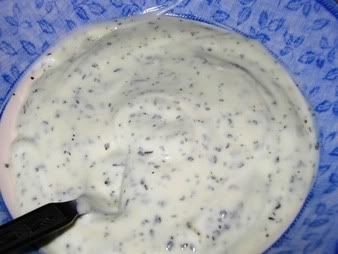
When I duplicated the recipe at home for Pete's friends one evening, though, I was completely taken aback by how much they raved about it. I tried telling them that it wasnt difficult to make, far from it... but they just wouldnt have it. Faced with so much insistent praise, I decided to accept the inevitable and gracefully let myself be crowned the Queen of Bhajis. Okay, so it's a dubious title, but mine own!
Just dont forget to address me as Your Royal Bhajiness.
Recipe for: Onion bhaji - UK-style
Ingredients:
3-4 medium sized onions, sliced thinly
About 1-1/2 cups gram flour/chickpea flour
1 tsp red chilli powder (more or less acc to taste)
1 htsp crushed or powdered coriander seeds
Salt to taste
3/4 cup water, more or less, as required
Oil to deep fry
Method:
1. Put the sliced onions in a big bowl and add the chilli powder, coriander powder and salt. Mix with a big flat spoon till evenly distributed.
2. Add the chickpea flour a little at a time, stirring again to coat the onions.
3. Now sprinkle water all over this, adding just enough to make the flour moist and stick to the onions - and it WILL be sticky.
4. Heat the oil - it's ready when a bit of bread sizzles immediately. Drop in the bhajis by the table spoon or by hand in bite-sized lumps. Fry on medium-high until golden brown and crisp on the outside. The inside should be soft but not raw.
5. Serve hot with instant mint raita as a dip. These are also nice with tomato ketchup or other condiments.
Recipe for instant mint raita:
1 tsp ready-prepared mint sauce or mint jelly
1 cup yogurt, beaten lightly
1/4 tsp salt
Mix the ingredients well and serve with the bhajis.
I used to think that poli was a South Indian recipe, until I found out that Maharashtrians make it for Makar Sankranti (harvest festival) - which necessitated a change in my world view somewhat, because people from the four Southern Indian States consider Maharashtra and Mumbai-ites to be North Indians... whereas people from the North India consider Maharashtrians to be more South Indian than north.
It doesnt help that Marathi as a language and its script are so much closer to Hindi and its script and not in the least like Tamil, Malayalam, Kannada or Telugu. All very confusing.
But to get back to the delights of poli... I might have mentioned this before, but I like coconut in very, very few sweet dishes. Poli isnt one of them dishes. So when I came across a recipe for poli that seemed different from the norm because of the stuffing ingredients - it contained sesame seeds but very little gram/chickpea flour and not any chana dal at all (cooked chana dal stuffing is what I've had thus far) - I was pleased. I love the taste of sesame in savoury and sweet dishes, so that was another plus.
I have to say that the poli made this way didnt stay soft for long. The traditional ones I've had, with mashed cooked gram dal & jaggery filling, are meltingly soft and delicious, especially with a dollop of ghee on top. The sesame-seed poli I made were delicious too, but - have I said this before? - not soft. Still, that didnt stop me scarfing them down, so I guess it's worth putting up the recipe.
If anybody wants to know how to make them soft... they'll have to look elsewhere for the answer. And if anybody does find the answer, would they be kind enough to pass on the info to me too, pleeeeeeeeeeeeease?
Recipe for: Sesame seed and jaggery poli (slightly adapted from Cuisine Cuisine)
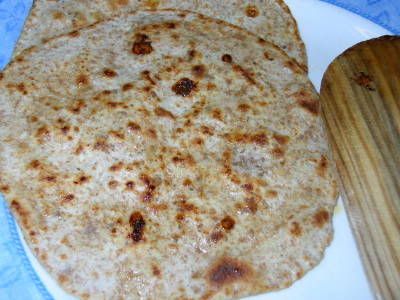
Ingredients:
For the stuffing:
1 cup jaggery, powdered
1 htbsp gram/chickpea flour
1 tsp cooking oil
1 tbsp poppy seeds
2 tbsp white sesame seeds
1/4 tsp cardamom seeds, powdered
For the poli:
2 cups plain flour
1 cup wholewheat flour
1 tbsp warmed oil
1/4 tsp salt
Warm water as required for making the dough
Plain flour for dusting
Ghee for shallow-frying
Method:
1. Make a soft but not sticky dough with the poli ingredients. Let it rest covered for about 30 minutes.
2. Heat 1 tsp oil in a little pan and roast the gram flour, stirring constantly, until the raw smell is gone (about a minute). Be careful not to burn the flour. Set aside to cool.
3. Roast the poppy seeds and sesame seeds on dry heat over medium flame till they start to turn golden. Grind these in a spice of coffee mill, together with the cardamom powder, into a fine powder. Mix with the roasted gram flour and reserve.
4. Put the powdered jaggery in a bowl, sprinkle a tsp of water, and melt in the microwave for a 45 seconds. Take it out and give it a stir. If it needs to melt a bit more - ie, if there are any dry bits - put it back in the microwave for 20 seconds. Dont overcook it by microwaving it for too long.
5. Quickly mix the sesame-poppy seed powder with the jaggery, making sure it's thoroughly mixed. Set aside to cool.
To make the poli:
6. Knead the dough well, then make small balls (slightly smaller than a golf ball).
7. Roll out two balls into palm-sized circles.
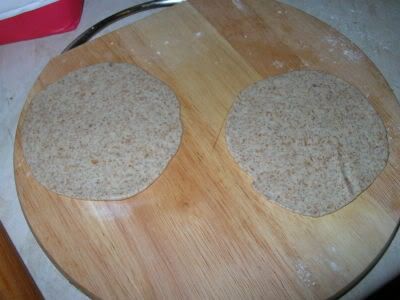
8. Sprinkle some of the filling all over one dough circle (break up any lumps with your fingers), then cover it with the other circle.
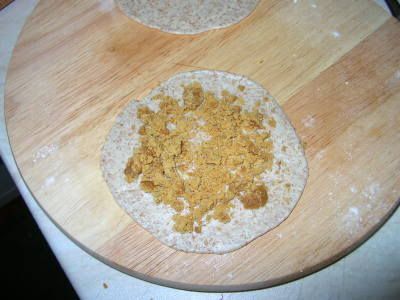
9. Dust the top with flour and gently roll out the dough circle into a slightly larger circle, so that the filling is sandwiched.
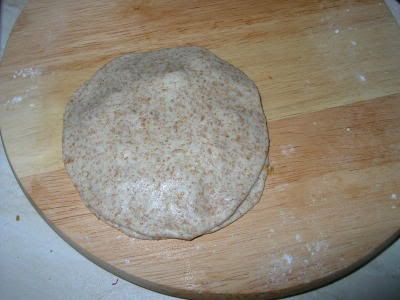
10. Then roll it out some more into a thin round.
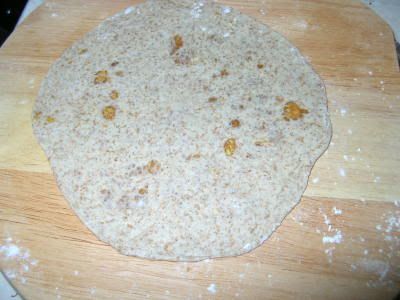
11. Heat a tava or frying pan (keep it on medium heat) and transfer the poli to it. Cook for a few seconds on one side, turn it over and smear that side with ghee. Flip it over once again and smear the other side with ghee as well. Shallow fry until the poli begins to get golden brown spots on both sides. Serve warm.
Note: The jaggery will melt in the heat and might ooze out - in that case keep an eye on it so that it doesnt burn. A little extra direct heat gives a caramelly flavour that is very nice, but burnt jaggery is quite awful to smell and taste.
I guess nada pakoda is one of those things that can only be made by using a traditional "press" that's ubiquitous in any South Indian household. If there's another way of doing it, I'm not aware of it. I suppose it might be possible to roll the dough out and cut into thin strips, but I dont think it would be worth the trouble.
However, with the use of a press, it's really easy and the end result extremely more-ish. Addictively more-ish, actually. The nada-maker is atriumph of simplicity. It's basically two cylinders with handles at the top, one cylinder hollow and the other slightly smaller (and not hollow) to fit inside the hollow one - as seen in the photos below. There are usually 3 or four plates with holes or slits of varying sizes (to make different kinds of savouries), which go inside the hollow cylinder - not all at the same time, though!
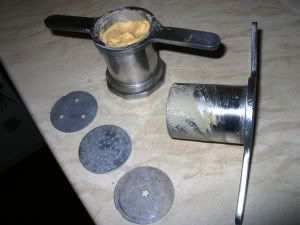
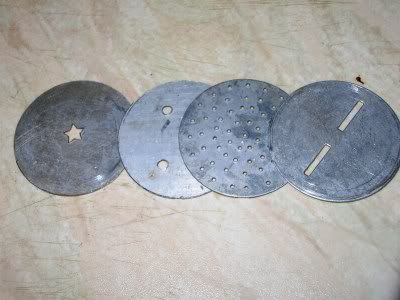
The dough is put inside the hollow cylinder with the appropriate plate inserted at the bottom, and the sealed cylinder is placed on top. Then using both sets of handles, the top cylinder is pushed into the bottom one, which forces the dough out in the desired shape - flat and ribbon-like, long and round like spaghetti, thin vermicelli-like, etc. The ribbon pakoda plate is the one on the far right.
What I made was the basic version but to vary the taste, a tbsp of garlic or onion paste can be added to the dough
Recipe for: Nada (ribbon) pakoda
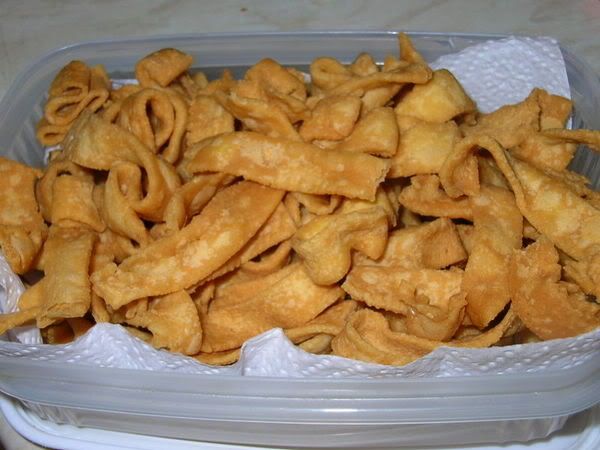
Ingredients:
2 cups rice flour
1 cup gram/chickpea flour
1 tsp red chilli powder
pinch of asafoetida
1 tbsp butter
1 generous tbsp white sesame seeds
OR
1 tbsp cumin powder
Salt to taste
Water as required to make dough
Oil for deep frying
Method:
1. Make a fairly stiff dough with all the ingredients - not TOO stiff, or it will be very difficult to press it through the mould, and not too "loose" or the dough will absorb too much oil and fall apart in the oil itself.
2. Heat the oil in a wok. If a piece of bread rises instantly to the top when dropped in, the oil is at the right temperature.
3. Break off a piece of the dough, roll it gently in your hand so that it fits into the hollow cylinder. (Leave a 1/2 cm gap at the top so that the dough doesnt come out messily at the top while being pressed.)
4. Use the press directly over the hot oil and squeeze out the dough in a circular motion. You can make 2-3 little portions or one big one which can be broken up later.
5. Fry the pakoda on medium heat till golden brown on both sides. Drain and place on absorbent kitchen paper. Store in an airtight tin when cool.




















































